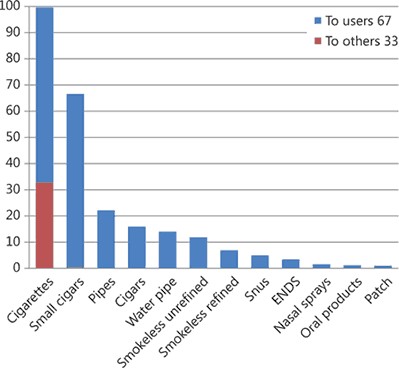Although most vapers know that vaping has been declared to be 95% safer than smoking by Public Health England, only a few know why. This article offers the backstory.
In 2015, Public Health England (PHE) had officially declared that “vaping is at least 95% safer than smoking”. A statement that the health organization confirmed in 2018, when it was time to launch its new campaign called “PHE’s Health Harms campaign”. However, despite the fact that the “95% safer” part of the news has made it across the world, most vapers are not aware of the scientific facts that led the PHE to make this declaration. Let’s explore this together.
A long process and many studies
The story starts in 2014 when the PHE ordered a report aiming to study the effect of vaping on health.
The report starts by stating that “electronic cigarettes contain toxic substances, including small amounts of formaldehyde and acetaldehyde” and other matter, but that the “levels of these substances are much lower than those in conventional cigarettes”.
The report goes on to explain the harm reduction derived from vaping, in comparison to smoking and proceeds to describe some of the advantages of using e-cigarettes instead of other nicotine replacement therapies (NRTs). “Electronic cigarettes offer nicotine delivery in a format that mimics smoking, have a socially acceptable non-medical image, which enables users to retain their smoker identity but without the risk of smoke”.
“Unlike NRT therefore, and particularly if nicotine delivery can be improved to mimic that of cigarettes more closely, these products have the potential mass appeal to challenge the primacy of smoked tobacco as the product of choice for nicotine users”, added the report authors. “The option of switching to electronic cigarettes as an alternative and much safer source of nicotine, as a personal lifestyle choice rather than medical service, has enormous potential to reach smokers currently refractory to existing approaches.”
One year later, the 2015 report, written by John Britton and Ilze Bogdanovica from the UK Centre for Tobacco and Alcohol Studies of the University of Nottingham, was presented to the organization. After inspecting the report, the PHE officially declared “the hazard associated with use of EC products currently on the market is likely to be extremely low, and certainly much lower than smoking and the health risks of passive exposure to electronic cigarette vapor are likely to be extremely low”.
Subsequently, the PHE had proceeded to release its own report. “These conclusions tally with a review by an international team of experts,which estimated the risks of vaping at less than 5% of the risks of smoking, and a comprehensive review of relevant literature by another international team which concluded that e-cigarettes aerosol can contain some of the toxicants present in tobacco smoke, but at levels which are much lower. Long-term health effects of e-cigarettes use are unknown but compared with cigarettes, e-cigarettes are likely to be much less, if at all, harmful to users or bystanders.”
The origin of the 95% figure

In order to better comprehend where the “at least 95 % safer” statement originated from, we need to take a look at another study conducted by an “international expert panel convened by the Independent Scientific Committee on Drugs”. The researchers of the latter “developed a multi-criteria decision analysis model of the relative importance of different types of harm related to the use of nicotine-containing products”.
Analyzing 12 products, 14 harm criteria were defined, 7 of which present harm to users and the other 7 present harm to bystanders. The study authors scored all the products on each criterion for their average harm worldwide using a scale with 100 defined as the most harmful product on a given criterion, and a score of zero defined as no harm.
So, is vaping safer? The results were as follows:

As clearly displayed above, ENDS (e-cigs) obtained a score of less than 5, meaning that the devices carry approximately 5% the risks of smoking. In other words “vaping is at least 95% safer than smoking”.
After reviewing the relevant scientific literature, the PHE concluded that the dangers associated with vaping may be “extremely low” in comparison to those associated with smoking.
Formaldehydes and acrolein

In order to ensure that the findings are accurate, the UK government had also looked into the compounds found in vapor, especially formaldehydes and acrolein.
The first research looking into these emissions was a Japanese study first mentioned in 2014 by the Japan Times, according to which “during the tests of various electronic cigarettes, one was responsible for emissions of formaldehydes 10 times higher than tobacco cigarettes”.
However, the PHE had explained that these toxic emissions only occurred when e-liquid was overheated. Meanwhile the study in question has never been published.
Very low toxic emissions when a personal vaporizer is normally used
A few months later, in January 2015, a similar study was released, according to which, when using a 3rd generation personal vaporizer, the rate of formaldehyde found in the aerosol was “5 to 15 times higher than a tobacco cigarette, when the personal vaporizer was used at maximum power, for 3 to 4 seconds”, causing a dry hit.
However in response to this, the PHE had explained that one has to bear in mind that these results were obtained by testing on smoking machines, and no vaper would take such long puffs at such power. Moreover, when e-cig users experience a dry hit, they instinctively spit out the vapor because of the unbearable taste, a taste that smoking machines do not detect. Therefore, although the presence of these toxic substances is undeniable in the case that e-liquid overheats, no vaper would inhale them repeatedly.
Vaping and Dry Hits
A few months later, these statements were confirmed by a study conducted by renowned anti-smoking expert and research fellow, Dr Konstantinos Farsalinos, at the Onassis Cardiac Surgery Center in Athens and at the University of Patras in Greece, who has been conducting laboratory and clinical research on e-cigarettes since 2011. During his research, the scientist reproduced the conditions of use of a personal vaporizer, in which these high levels of formaldehyde had been detected.
Farsalinos reported that none of the vapers participating in the study were able to vape under the same conditions as the smoking machines. All were forced to spit out the vapor because of the dry hits caused. Additionally, he said, under normal use the levels of toxic compounds present in the aerosol were “absent or negligible”.
Similarly, with regards to acrolein, other scientists have shown that vapers have “much lower levels of acrolein and crotonaldehyde in their urine than tobacco smokers”.
Note: A vaporizer produces higher levels of formaldehyde than smoking, only when used under poor and unrealistic conditions. In normal use, the vapor produced by an electronic cigarette contains “absent or negligible” levels of toxic compounds.
Vaping and lung problems

Another major study which identified health problems caused by vaping was conducted in February 2015. By locking mice in a box and exposing them to the aerosol of an electronic cigarette, the research team concluded that vaping causes “inflammation and infection of the lungs, and even cancer“.
The PHE had once again pointed out there were several problems with this study. The first is that an e-cigarette should be considered only as a tool to reduce the risks associated with smoking. Therefore, any study that seeks to highlight problems caused by vaping, must compare them with problems caused by smoking, which this study did not do.
The second issue with this study, was that the group of mice exposed to e-cig vapor was “much more stressed” than the control group and stress is known to affect “bacterial and viral responses”. Therefore once again, the results of this study were deemed unreliable.
Moreover, given the confinement of the mice, they also “suffered from repeated nicotine poisonings”. The UK Department of Health explains that accelerated weight loss, reduced immunity and early death of animals “were much more likely to result from prolonged stress and nicotine poisoning than from exposure to free radicals”, especially give the fact that free radicals which according to the study, were present in the e-cig aerosol, were “at levels 1,000 times lower than in tobacco cigarettes”.
In the same year, another study revealed similar results. However, as the UK Department of Health pointed out, “once again, no comparison with smoking has been made”.
Note: the only symptoms currently reported when using a vape, are local irritation of the mouth and drying of the mouth. Concerning the respiratory tract, research has shown an improvement in the condition of smokers with asthma. Another study has found no significant effect on the human body following the use of an electronic cigarette for 1.5 years. (Reprinted from VAPINGPOST)





